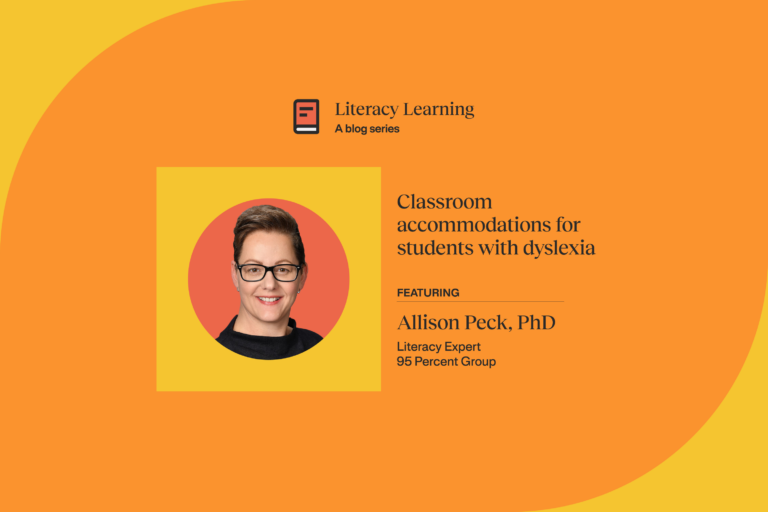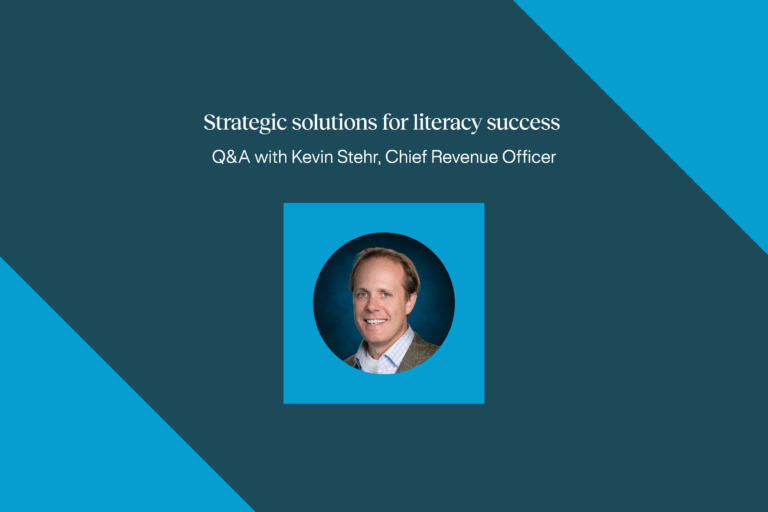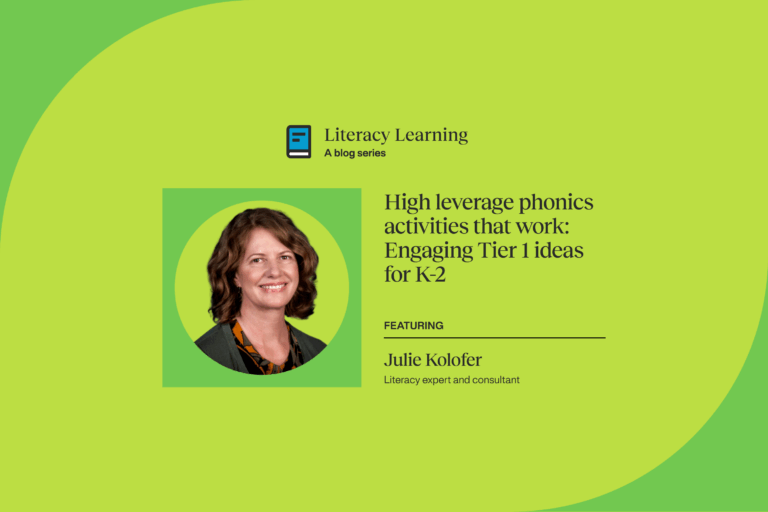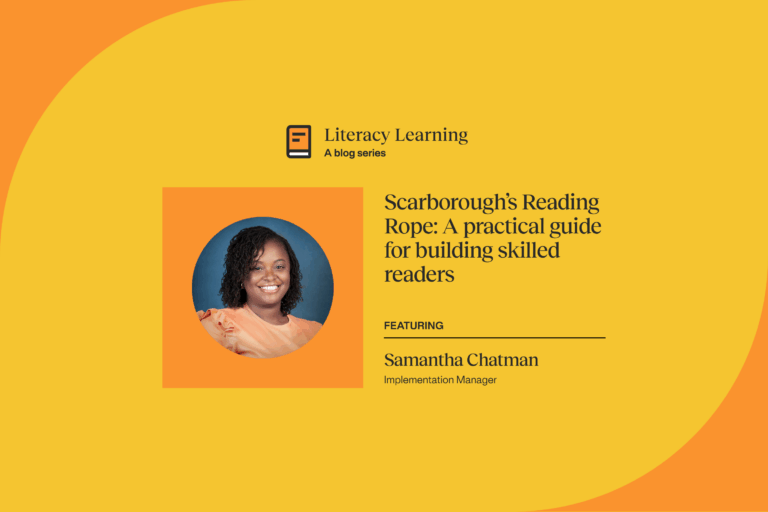Personalized classroom accommodations for students with dyslexia
A post from our Literacy Learning: Science of reading blog series written by teachers, for teachers, this series provides educators with the knowledge and best practices needed to sharpen their skills and bring effective science of reading-informed strategies to the classroom.

Students understanding and having a say in what they need to be successful in the classroom is going to be THE thing that leads them to success in the long term.
Allison Peck, PhD, CALT-QI, LDT, C-SLDS
When it comes to dyslexia, two things are true: dyslexia can make reading much more difficult, AND, with explicit instruction, almost all those with dyslexia can learn to read. According to the International Dyslexia Association (IDA), “dyslexia is a neurological condition—a different wiring of the brain—that affects between 10 and 20 percent of the population; and often goes undiagnosed.”
For individuals who have a dyslexia diagnosis, or who suspect they have dyslexia, the best possible intervention is structured literacy: literacy instruction that is explicit, systematic, sequential and grounded in science. For the purposes of this specific language disorder, instruction that is also multisensory—using strategies that engage visual, auditory, and frequently, tactile senses—is often the most effective option.
Understanding dyslexia in the classroom
Dyslexia is a neurological learning disability where the mind has trouble processing and understanding words and letters. While there is a lot of false information out there about the way children with dyslexia learn and what they are and aren’t capable of, research has shown that there is no correlation between dyslexia and intelligence. This means that children with dyslexia are no more or less intelligent than children without dyslexia.
When children that have dyslexia (especially if it’s undiagnosed) are struggling with language-based skills, it can appear to their teachers that they are unwilling or unable to engage in certain tasks. It’s critical that educators are curious about these situations and endeavor to understand when a student seems unmotivated or “lazy.” Frequently, it’s due to an underlying difficulty in what they are being asked to do. With knowledge and understanding, all those invested in a child can help support their reading and learning. One way to do this is to be aware of common challenges that arise for students with dyslexia, and know when to seek out more information.
According to the IDA, the chief underlying cause of dyslexia is problems with phonological processing: the ability to analyze speech or spoken language, from identifying individual words, to word parts or syllables, and then into the smallest parts called phonemes or speech sounds. One common sign of dyslexia is when a student is reading at a level significantly lower than would be expected according to their academic performance otherwise. Some of these challenges present as difficulty with:
- Rapid Automatic Naming and working memory
- Decoding words and distinguishing between certain short vowel sounds
- Spelling words with both phonetic and irregular spelling patterns
- Reading comprehension—even if it seems like they can decode
Types of classroom accommodations for students with dyslexia
Students—all students, but particularly those with dyslexia or other learning needs—need to eventually be able to walk into a learning environment and be their own best advocates.
Allison Peck, PhD, CALT-QI, LDT, C-SLDS
The idea of giving a student accommodations for learning is sometimes misunderstood. Allison Peck, literacy expert and consultant for 95 Percent Group, explains that the goal is to make the learning accessible for all students. She compares offering accommodations to providing a pair of glasses to someone with poor eyesight—so that everyone can access the same information in front of them. Access is the key word here.

Accommodations vs modifications
“There is often confusion when it comes to accommodations vs modifications,” Peck explained. “While a severe case of dyslexia, or one with a second diagnosis (ADHD for example) might need both, frequently, we aren’t modifying anything. We aren’t changing the standards or the expectations. We are just providing an additional tool so that the student with dyslexia can access all of the information they need to be successful.”
In fact, the International Dyslexia Association (IDA) has this to say about accommodations for dyslexia: “Accommodations do not change the content of instruction, give students an unfair advantage, or change the skills or knowledge that a test measures.”
According to the IDA, there are four basic types of accommodations: presentation, response, setting and timing. Of these four, the first three affect the daily classroom the most. Accommodations are personalized and must be chosen and used wisely. Students need time practicing in daily classroom settings before use during assessment.
Instructional accommodations: Presentation
Instructional accommodations are those that allow students to access instructional materials without having to read standard print. The IDA refers to these as “presentation accommodations.”
- Verbal instructions and repetition of instructions
- Larger print
- Copies of notes or note taking assistance (teacher-provided or peer-provided). Notes can look different (copies of slides, fill-in-the-blanks notes, etc.)
- Chunking into manageable pieces: eliminating more extraneous questions, fewer items given without eliminating any concepts
- Visual prompts or cues and highlighted text
- Digital textbooks or audio textbooks to all necessary materials
Instructional accommodations: Response
Response accommodations allow students to show what they know for completion of activities, assignments, or tests using alternative means, and/or the help of technology. Some response accommodations include:
- Marking answers in test book instead of on separate answer sheet
- Having a word bank instead of having to come up with words on their own
- Dictating to scribe or recording oral responses on audio-recorder
- Pointing to their response choices
- Typing (keyboard) their response.
One of the biggest challenges for students with dyslexia is the cognitive overload that often comes with reading and writing. To help with this, it’s important to give students what they need to be successful with the actual task at hand.
Setting accommodations: Creating a dyslexia-friendly classroom environment
It can take away some of the anxiety when a student with dyslexia has a copy of the notes, versus if they’re responsible for everything, right? Just relieving some of that so they can be open-minded and open-hearted to learning without the anxiety and anxiousness of ‘how am I going to get all this information down?’ It’s a world of difference.
Allison Peck, PhD, CALT-QI, LDT, C-SLDS
Setting up an inclusive and dyslexia-friendly classroom, comes down to teacher knowledge of dyslexia, Peck explains, “When teachers understand what the frustrations are and how they can best help their students with dyslexia,” Peck said, “this can make all the difference. These students want to be just like their peers, but need the access [to materials] to do so.”
Here are a few examples of setting accommodations:
- Individual or small group instruction
- Reducing visual and/or auditory distractions (e.g., separate desk or location within classroom—“private office”)
- Alternative furniture arrangement (e.g., facing front or teacher for whole group lessons vs block of tables for small group work)
Some questions educators can explore within their classroom setting are:
- How does teacher support play a role? Teachers need an understanding of the small things that can be super helpful for a student with dyslexia, and can change their perspective on the way that student learns.
- How does peer support play a role? One way to foster student connection is to have a peer help provide notes for a student with dyslexia. Peck has a unique perspective on this one. “If you know your students well and can find a student who understands the way they are helping a peer, it can go a long way in building connections and creating a safe learning environment for everyone. My experience has been that eventually, everyone is more willing to help each other out.”
Testing accommodations: Timing and setting
Although testing wouldn’t be considered a daily classroom experience, it is a fairly regular part of learning once a student is in upper elementary school. Additional timing is a go-to, but it isn’t always the answer for a student with dyslexia. There are specific circumstances—especially those that will be a written response that needs to include a high volume of thoughtful, organized information (think an essay in English or Social Studies or a lab report in science)—where having additional time can mean the difference between being able to truly express their understanding of a concept or not.
Peck did speak to the difficulty of always being able to offer extended time on a test. “This is a hard one for some schools to follow through on with integrity,” Peck warned about the difficulty of offering extended time in every situation. “It requires more personnel, often an extra adult and a free space to be in with that student while they finish a task or an exam. Finishing a test the next day or missing out on learning time to finish something isn’t always the best way forward,” she added.
This dilemma does resolve a bit as students get older—often there are more rooms and adults available to supervise in middle and high school.
Here are a few other examples of testing accommodations:
- Flexible scheduling (e.g., several sessions vs one)
- Allowing for more frequent breaks (as appropriate)
- Changing order of tasks or subtests
For more information and a full list of accommodations for students with dyslexia, please visit the factsheets on the International Dyslexia Association’s website!
Recommended apps and tools
The science of reading provides decades of conclusive research showing us that the best approach to teaching all children how to read, especially those diagnosed with dyslexia, is systematic and sequential, direct instruction of foundational literacy skills. 95 Percent Group’s One 95 Literacy Ecosystem™ provides all the tools educators need for skill instruction across the Tiers.
When students need Tier 3 intensive intervention, teachers can now turn to 95 RAP (Reading Achievement Program)™, a technology-based solution for students who have difficulty learning to read, including those with dyslexia.
Interested in learning more about how teachers are using this tool? Check out this story about teachers in North Carolina whose Tier 3 students are successfully mastering skills in phonemic awareness, phonics, fluency and comprehension using 95 RAP.
Conclusion
The most important thing to understand is that with the right instruction and accommodations, students with dyslexia CAN be successful readers and thrive in their academic experience and beyond. The one thing Peck emphasized more than anything else? Teaching children to be their own best advocate.
“Parents or even teachers cannot make the decision on what students need to be successful,” she implored. “We have to build the advocacy piece, because at the end of the day, for a student to go through school understanding what accommodations they need—and being able to speak to that—is the key to their success. When they get to college, every semester they will have to go into that support office and they will have to say ‘this is what I need.’ They will have to be able to speak to their professors and know inside and out what will help them to access the information so they can learn and demonstrate that learning.”
With a full understanding of the students we teach, and the right personalized accommodations, we can start helping kids understand who they are and what they need as early as possible. With support and the knowledge of what they need to learn, all children can hold the keys to unlocking their fullest potential.
Looking for more resources? This blog post offers tips for both teachers and parents to support the type of reading instruction that will be most effective for students with dyslexia.

Expert biography
Allison Peck, PhD, CALT-QI, LDT, C-SLDS
Literacy Expert and Consultant, 95 Percent Group
Allison Peck became a Certified Academic Language Therapist after her oldest child was diagnosed with dyslexia and she wanted to be able to help him learn to be a competent reader. Armed with the knowledge of an Orton-Gillingham program and the science of reading, she then went into the public school system as a special education, general education, and reading specialist teacher, with her experience being in middle and elementary school settings. She completed her PhD in Literacy at St. John’s University in New York with her research focusing on the impact of using structured oral language in the classroom and the impact on student writing. She currently serves in the role of Consultant for 95 Percent Group and has the privilege of working with administrators and teachers across the country.



